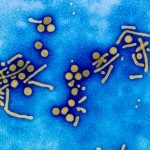Link to Pubmed [PMID] – 26143443
J. Hepatol. 2015 Nov;63(5):1093-102
BACKGROUND & AIMS: Maintenance of the covalently closed circular HBV DNA (cccDNA) that serves as a template for HBV transcription is responsible for the failure of antiviral therapies. While studies in chronic hepatitis patients have shown that high viremia correlates with hyperacetylation of cccDNA-associated histones, the molecular mechanisms controlling cccDNA stability and transcriptional regulation are still poorly understood. This study aimed to decipher the role of chromatin and chromatin modifier proteins on HBV transcription.
METHODS: We analyzed the chromatin structure of actively transcribed or silenced cccDNA by infecting primary human hepatocytes and differentiated HepaRG cells with wild-type virus or virus deficient (HBVX-) for the expression of hepatitis B virus X protein (HBx), that is required for HBV expression.
RESULTS: In the absence of HBx, HBV cccDNA was transcriptionally silenced with the concomitant decrease of histone 3 (H3) acetylation and H3K4me3, increase of H3 di- and tri-methylation (H3K9me) and the recruitment of heterochromatin protein 1 factors (HP1) that correlate with condensed chromatin. SETDB1 was found to be the main histone methyltransferase responsible for the deposition of H3K9me3 and HBV repression. Finally, full transcriptional reactivation of HBVX- upon HBx re-expression correlated with an increase of histone acetylation and H3K4me3, and a concomitant decrease of HP1 binding and of H3K9me3 on the cccDNA.
CONCLUSION: Upon HBV infection, cellular mechanisms involving SETDB1-mediated H3K9me3 and HP1 induce silencing of HBV cccDNA transcription through modulation of chromatin structure. HBx is able to relieve this repression and allow the establishment of active chromatin.


